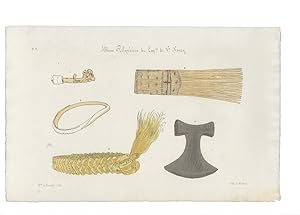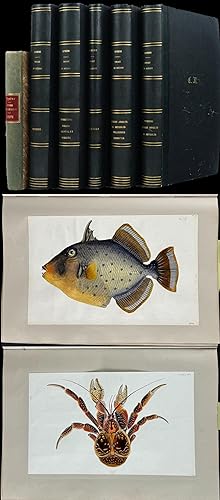charles gaetan noury (2 résultats)
Type d'article
- Tous les types d'articles
- Livres (1)
- Magazines & Périodiques
- Bandes dessinées
- Partitions de musique
- Art, Affiches et Gravures (1)
- Photographies
- Cartes
-
Manuscrits &
Papiers anciens
Etat
- Tous
- Neuf
- Ancien ou d'occasion
Reliure
Particularités
- Edition originale
- Signé (1)
- Jaquette
- Avec images
- Sans impression à la demande
Pays
Evaluation du vendeur
-
Album Polynésien de M. C. Noury, Capitaine de Vaisseau
Edité par Olivier Merson, Nantes, 1861
Vendeur : Hordern House Rare Books, Surry Hills, NSW, Australie
Folio (390 x 260 mm), 17 leaves in all, untrimmed and unbound as issued, with lithographed title-page and single sheet of description, and 15 lithographed plates,seven of which are coloured and eight in black on a tinted background, on paper watermarked either "Rives" or "D & C Blauw"; in a modern full morocco fitted case. Exceptionally uncommon and most beautiful work on tattooing, ethnography, and decorative carving in the Marquesas; 'd'un grand intérêt ethnographique' (O'Reilly), this is a remarkable collection of images of actual objects and original personal observation made during the early period of French influence in Nuku Hiva. The quality of the illustrated plates is outstanding, and the delicate lithography is a marvellous medium for conveying the immediacy of the original sketches; this very rare work is an important record of French Polynesia in the South Pacific, and is almost unknown on the market. Published by a tiny lithographic press in the author's hometown of Nantes on the French Atlantic coast, the signatures of three artists appear on the various lithographic plates: B. de Girardot, Bourgerel and Alfred Clericeau. Clericeau is also credited as printer of some of the plates, most of which were printed by Olivier Merson in Nantes, who is listed as publisher of the work on the title-page. Baron Girardot Of the three artists, Auguste Théodore, baron de Girardot (1815-1883) was responsible for plates 1-2, 5 and 7-9. He was an archaeologist and antiquary in Nantes, with prolific publications to his name, including numerous lithographs of archaeological objects in similar style to the present work. We speculate that he may have been the overall creator of the work and that the wording of the title, somewhat ambiguous, may refer to the collection of M. Noury rather than crediting the work to him. As Anna Andruszkiewicz's study of Girardot shows, several of Girardot's publications were, like the present work, produced on Olivier Merson's press. Certainly, his involvement in the publication was close: the copy of this work in the Mitchell Library, for example, has a presentation inscription from him. Charles Noury Charles-Gaëtan Noury (1809-1869) was a French naval officer born in Nantes (he was also titled: his father Gabriel Noury was the first Baron Noury). He was promoted capitaine de corvette and second-in-command of the Sirène in 1846, bound for the Pacific. The ship arrived at Papeete in May 1847 where captain Lavaud took over the shore command, leaving Noury in command of the Sirène. Shortly after Noury served for a year as the commandant of Nuku Hiva, the main French settlement in the Marquesas, where he became a student of local customs, researching especially tattooing, cannibalism, and language and evidently a keen collector. An 1849 letter from him preserved in the Mitchell Library discusses his records of the ritual chants sung at human sacrifices, for example, while a collection of more than 1200 shells from Tahiti and the Marquesas was donated by his descendants to the Nantes Museum in 1904. The Sirène returned to France after four years, and Noury continued to serve in the French Navy until 1864, retiring to Nantes. In his retirement he worked on Polynesian natural history and linguistics, and took stock of his collection of South Sea curiosities: given the date of publication here, and the fact that the lithographs are based on sketches by artists other than Noury, it is probably fair to assume that the illustrations depict items in his collection (where are they now?). Noury is not a well-known figure, but there is a helpful potted biography in Father O'Reilly's Tahitiens (1975). Noury also left a manuscript journal illustrated with watercolours devoted to the natural history of Tahiti and the Marquesas which, rediscovered in modern times, was finally published 160 years after its creation by the Royal Academy of Belgium as Voyage en Polynésie (1847-1850). Le bestiaire oublié du capitaine Noury, ed. M. Jangoux (2017). Marquesan artefacts, and the queen's tattooed hand The illustrations in the work show an extraordinary array of Marquesan artefacts, including native surgical instruments, instruments for making tapa, a coconut shell fashioned into a cover for the wound left by the practice of trepanning, designs carved into whale teeth, idols (including one meant to be suspended from canoe prows), as well as ornaments, pipes, jewellery including necklaces and bracelets, puzzles, hooks, decorative clubs, a "war conch" and other sculptures. The most beautiful of the images is that of the tattooed hand which, particularly graceful and beautiful, has spawned a small literature of its own since it depicts the famous tattoos of Queen Vaekehu (1823-1901). In 1886 Albert Davin spoke with the queen and learned more about her tattooing: he quotes her (in 50,000 milles dans l'ocean Pacifique, 1886) as saying, through her interpreter: "Oh I suffered cruelly. I cried much. For several days my hands stayed large as breadfruits. It was in vain that I asked my mother to put an end to my suffering. All was useless. It was necessary that the tattooing of my hands and arms to my shoulders, of the feet and the knees, of the mouth and the ears, reveal my noble origin.". Davin noted that the tattoos were by different artists from the island of Ua Pou (home of the best tattooists in the archipelago at that time) but done so well and so similarly that they appeared the work of one. (Quoted by Carol S. Ivory, Vaekehu, The Life of a 19th-century Marquesan Queen in Turbulent Times, Journal of the Polynesian Society 123(2): 113-128). Karl von den Steinen, who met the queen when he visited the islands in 1897, used this Noury/Girardot image of her hand to illustrate his account (Reise nach den Marquesas, 1897). Nuku Hiva Nuku Hiva was first visited by the American Joseph Ingraham on the Hope as early as 1791, and the Marquesan group was claimed for the United States in 1813 by Commodore.
-
First Zoological Inventory of Polynesia - Noury's Fregate la Sireneâ ¦ 458 Original Illustrations in 5 Volumes, 1 Hand-written Text Volume, and 1 Modern publication of the Manuscript
Date d'édition : 1850
Vendeur : Trillium Antique Prints & Rare Books, Franklin, TN, Etats-Unis
Art / Affiche / Gravure Signé
Hardcover. Etat : Fine. This historically significant manuscript is the 'First Zoological Inventory of Polynesia.' The work based on the research of Charles-Gaëtan Noury is entitled Frà gate la Sirene, commendà e par Mr. Noury Capitaine de Frà gate. Histoire naturelle. Voyage dans l'Oceanie, annà es 1847, 1848 & 1849. Iles de la Socià tà , Tahiti & Marquises, Nouka hiva and was unknown until 2017. The work was completed in France after 1850.The manuscript is in 6 volumes, one volume of text and five volumes with 458 illustrations (including 444 watercolors, 10 pen drawings, and 4 pencil drawings). Each illustration is mounted on card and often has French handwritten descriptors with local names. The five volumes with illustrations are bound in green half morocco with gold details and monogram of C.N. to the front boards. The text volume is bound in half-cloth. Also included in the lot is the manuscript published on behalf of the Belgian Academy of Sciences by Michel Jangou after the discovery of this one of a kind work of Noury's. Jangou's publication is entitled Voyage en Polynà sie (1847-1850): Le bestiaire oublià du capitaine Noury and was published in Brüssel in 2017 (available on Amazon as well).All of the illustrations and text were based on the scientific findings of Charles-Gaëtan Noury. It encompassed the entire animal kingdom of Polynesia creating the 'First Zoological Inventory of Polynesia.' Michel Jangou commented in his publication of the manuscript that "Noury produced a pioneering work, the first zoological inventory of Polynesia! He compiled it discreetly, with the invaluable help of a talented painter who remains anonymous. Since then, Noury 's manuscript and the watercolors which illustrate it have remained ignored by everything: it took more than a century and a half for the captain's work, still intact, to find the light and finally be revealed to us." (p. 39)Noury divided the animals into individual classes. The artist depicted the animals with brilliant colors and a mastery of detail. The manuscript depicted several previously unknown species. Watercolor number 183 features a detailed autographed commentary from Noury himself. Noury's text was mainly dedicated to his zoological findings with a smaller section on plants. The individual classes and sections are introduced by a summary table, which follows Milne Edwards zoological classification system of mammals, birds, reptiles, fish, ringed animals, insects, myriapods, arachnids, crustaceans, molluscs, and zoophytes. His descriptions were often enriched with island anecdotes.Charles-Gaëtan Noury (1809-1869) was a French naval officer and naturalist. He boarded the Sirà ne in Brest, France in 1846 as the deputy to Commander Lavaud. Lavaud had been appointed governor of the French settlements in Oceania. While Lavaud served as governor, Noury had command of the Sirà ne and stationed in Papeete (Tahiti). He dedicated himself to scientific research there and with the help of painters produced this remarkable astonishing manuscript.Noury had one work published in Nantes in 1861 entitled Album Polynà sien de M. C. Noury, Capitaine de Vaisseau which showed images of tattoos and artifacts of South Sea curiosities. This work with 15 plates is currently on the market at 25,000 EUR.This one of a kind manuscript from Noury offered here remained undiscovered for over 160 years. It features 458 illustrations and hand-written scientific text that make it a truly astonishing work for any collection.Additional photos available upon request. --- The work is in very good to excellent condition overall. The bindings are slightly rubbed. There can be some faint foxing to title or illustrations. There may be a few minor imperfections to be expected with age. Please review the image carefully for condition and contact us with any questions. --- Paper Size Image or Sheet Size ~ 12 3/4" by 8 1/4"; Mounting Card Size ~ 16 3/8" by 11 3/8" Image or Sheet Size ~ 12 3/4" by 8 1/4"; Mo. Signed by Author.



